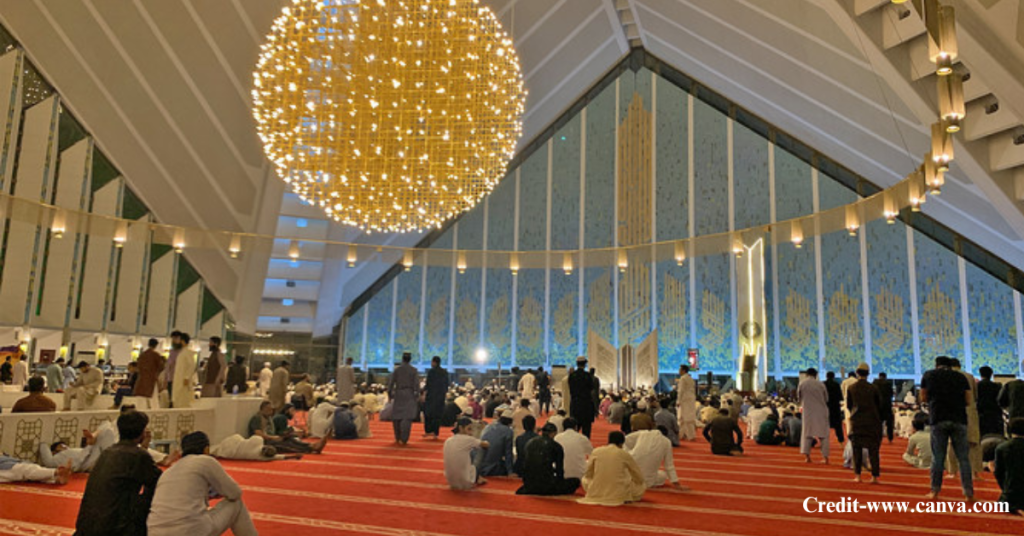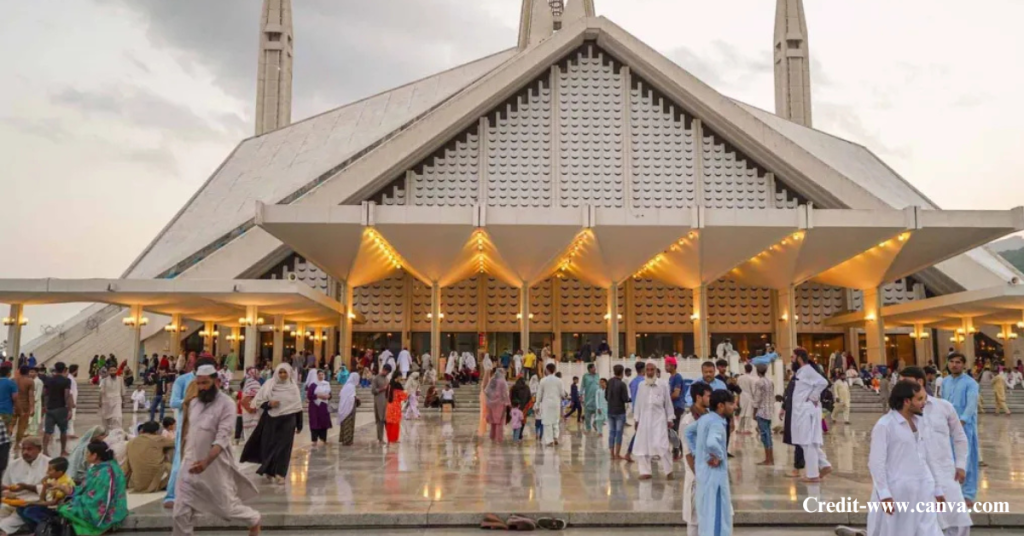As you drive into Islamabad and look up, you’ll spot it right away—a sharp white triangle rising into the sky, with four thin towers around it. That’s Faisal Masjid. But it’s not just another mosque. It’s a bold idea, a mix of tradition and change, and a space that makes you pause and think.
In this blog, we’ll look at what makes Faisal Masjid different—its story, design, and some tips most guides won’t tell you: no fancy words, no confusing terms—just real info, easy talk, and local vibes.
Table of Contents

A Royal Plan with a Big Idea
Back in 1966, Saudi King Faisal visited Pakistan. During his trip, he gave money to build a grand mosque in Islamabad. At the time, Islamabad was still new and growing as the capital city. His offer kicked off a global design competition.
The winner? Vedat Dalokay is an architect from Turkey. His design shocked many people.
No dome. No big arches. Just clean lines and a roof shaped like a desert tent. Some thought it looked too modern. Dalokay’s idea was different – it was simple, but it carried power.
Work began in 1976. By 1988, Faisal Masjid took in its first prayers. What started as a sketch became a famous place in Pakistan.
A Design That Makes You Look Twice
The design isn’t something you forget.
Dalokay used ideas from two things—the Kaaba in Makkah and the tents used by people in the desert. He didn’t just copy old buildings. He created a new shape that still felt familiar to Muslims.
A roof forms a pyramid shape but bends a little. The shape, called a “hyperbolic paraboloid,” appears complex. This design lets the roof hold up without inside pillars. The space is bright and clean.
The white roof lines up with the Margalla Hills behind it. Designers planned this connection. The mosque appears to come from the hills, not just sit before them.
About the minarets – Four stand 90 meters high. The tall, thin structures show from far across the city. People who never visited the mosque often saw the towers from the highway.
Open Space, Open Feel
Visitors immediately see the lack of walls. There is no large gate – it appears open on all sides. A large marble base holds the mosque, which rests some steps above the ground. The main prayer room holds about 10,000 people. On Eid and other special days, nearly 300,000 more individuals pray there. From 1986 to 1993, a mosque was the largest on the planet.
Its size is not the only significant feature. It’s the feeling. You walk in and feel calm. The open setup, clear sky, cool breeze from the hills—it all helps you breathe easily.
Step Inside: Light, Art, and Quiet
When you walk inside, the noise of the world lessens.
The white marble gleams gently as light enters through colored glass windows. A large chandelier hangs above. Workers brought it from Turkey – it illuminates the area without shining too much.
The artwork also draws attention. A Pakistani calligrapher with a good reputation put his art on the mosque’s walls and mihrab. The mihrab faces Makkah. His style does not just involve writing words. It shapes them into designs.
You might not read all the Arabic, but you’ll feel the art. The whole space is simple, not flashy, and full of meaning.
From “Too Modern” to Iconic
When Dalokay’s design first came out, it sparked debate. Many people weren’t sure about a mosque without a dome or classic arches. Some thought it looked too sharp. Others said it didn’t feel traditional.
But over time, that changed.
Now, Faisal Masjid is a symbol of modern Islamic design. It appears in lists of the world’s most beautiful mosques. It’s even printed on Pakistani currency notes.
Groups like the Aga Khan team and the UK’s C20 Society have praised its innovative and new way of building a spiritual place. It proved that a mosque can be bold and respectful at the same time.
Local Tips You Won’t Hear Everywhere
Let’s talk about the stuff guides don’t usually mention:
- A missing dome caused problems initially. People understood the design when they saw the whole building.
- Non-Muslim people can visit. Please do not come during Friday prayer. Wear proper clothes, so avoid shorts or shirts without sleeves. Women should wear a head covering – the mosque provides these at the entrance. Please feel free to take off your shoes.
- A person gets good photos early in the morning or near sunset. The white marble shifts colour in soft light—the hills behind the building shine.
- The building contains a library, a museum, a café, and a lecture hall – it once held the International Islamic University.
- Few people are aware that General Zia-ul-Haq’s grave is next to the mosque. It lies in a quiet area at the back.
Details That Matter More Than You Think
This mosque isn’t just beautiful—it’s full of innovative ideas.
- Roof shape: The curved roof helps spread weight across the whole space. That’s why the prayer hall doesn’t need columns in the middle—it’s strong, light, and lets everyone see the mihrab.
- Mihrab design: It’s not the usual half-circle. Here, it’s shaped like an open book, showing the Qur’an’s importance.
- Calligraphy style: Sadequain used a special style called Hurufiyya. It turns letters into shapes, making each wall a mix of text and art.
- White marble: White wasn’t picked just because it looks nice. It reflects light, keeps the space cool, and matches the clean clothes worn during prayer.
Pop Culture, Money & Fun Facts
- The 5000-rupee note shows the Faisal Masjid. So it belongs to Pakistan’s values.
- This mosque appears in novels, for example, The Kite Runner – it is a proud landmark of Pakistan.
- Islamabad’s city team put more than 200 million rupees aside; they wanted to fix the tiles, walkways, and lights.
- The mosque holds school tours. It also has community talks and large religious lectures.
Plan Your Visit: Travel Tips
Here’s a quick list to help your trip:
- Where: Right at the base of Margalla Hills, E-8 sector, Islamabad.
- How to get there: About 15 minutes from the Blue Area. You can use Uber, Careem, or a taxi. If you’re using Metrobus, you’ll need a short ride after.
- Admission does not cost money.
- The location is open every day. People can go there from nine in the morning until nine at night. Please don’t visit during prayer times.
- Cover your arms and legs. Women must put a cloth over their heads. Some places offer scarves at the entrance.
- Could you remove your shoes before you go inside? You may put them in a bag or leave them outside.
- Close places to visit include Daman-e-Koh. There you can see Islamabad. Saidpur Village has food. Pir Sohawa offers cool air.
Why Faisal Masjid Still Matters
Faisal Masjid is a building – it represents how belief and brave thoughts join. The design shows that it does not need to remain the same to hold meaning.
It departs from old practices, yet it keeps the deep convictions behind it. This mix sets it apart, not only in Pakistan but across the globe.
A tourist, a local person, or someone simply curious, will feel something when they come to the site. It is not only what one sees, but what lingers after leaving, that affects a person.
FAQs
Does it cost money to enter?
People do not pay to enter the mosque.
Must women cover their heads?
Women must wear headscarves. The mosque usually offers a scarf if you forget yours.
What makes Faisal Masjid stand out?
The mosque shows a new style, an open layout, along with tall towers. Its design has a plain look and a deep meaning.
Was it the largest mosque in the world?
From 1986 to 1993, it was the largest. It remains one of the biggest mosques in South Asia.
Who planned its design?
Vedat Dalokay from Turkey planned the design. His idea won the design contest.
Can I take pictures?
You can take pictures. Be polite and do not take photos during prayers.

Final Thoughts
The Faisal Mosque in Islamabad illustrates how belief and modern thought join – it contains no dome. It still appears spiritual. The building does not follow old styles, but it seems correct.
Workers shaped the open air, the straight lines, the writing inside, and the roof with care. People visit Faisal Masjid to pray, to take pictures, or just to look. The building offers more than views – it provides a lasting feeling.
If you are in Islamabad, you should go there. You can visit in the early morning, at sunset, or when the sky is clear. Spend a few quiet minutes there. You will take away more than pictures – you will take away peace.

